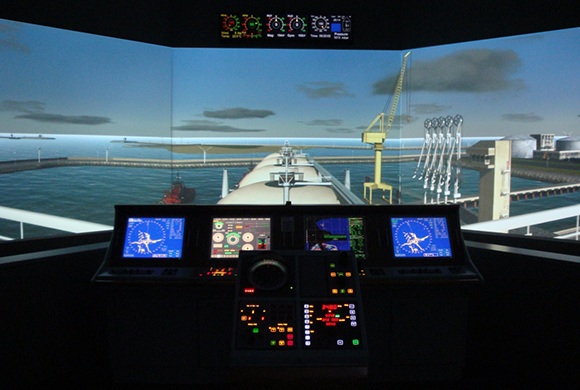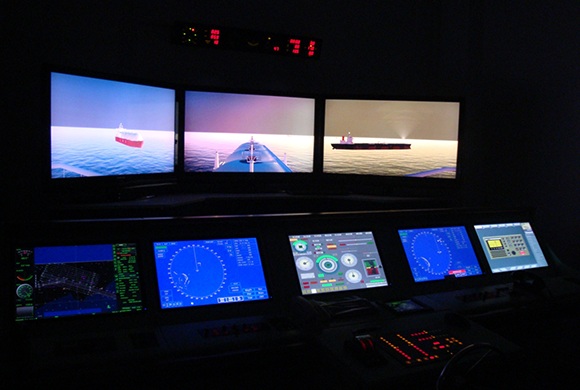Navigational Simulator
Navi-Trainer Professional 5000 navigational simulator has been designed in full compliance with the requirements of the revised STCW '95 (as amended in 2010) and satisfy the needs of all important areas of maritime training, including:
- Bridge Team Management
- Bridge Resource Management
- Maritime Resource Management
- Ship handling
- ECDIS
- ARPA/Radar
- Tugs and mooring operations
- Pilot training
- SAR operations
and many other areas, in which a high level of education and professional expertise of bridge personnel is required.
Compliance with International Standards and Regulations
- International Convention of Training, Certification and Watchkeeping for Seafarers (STCW’2010)
- IMO model courses
- International SOLAS Conventions
- Approved by DNV (with class notation INTEGRATED SIMULATORSYSTEM, NAUT AW (SIM), DYNPOS – AUT (SIM), HSC, TUG, ICE to theClass A Standard for Certification of Maritime Simulators No. 2.14October 2007)
- Regulations concerning ‘special’ training: fishing operations, VTSoperator training etc.
Flexibility and Expandability
The exceptional power of the software built into the TransasNavi Trainer Professional 5000 simulator allows training in different aspects of seamanship to be emphasised within the same configuration of standard module-based simulator software and hardware.
The modular structure allows us to adjust the configuration of the two bridges to fit specific training needs. We are equipped with eight multifunctional stations. The two bridge modules can be configured either as two full mission bridges (two Radar/ARPA stations, one Conning station and one ECDIS NS4000), or, depending of the course requirements, can be configured as either eight Radar/ARPA stations (in case Radar/ARPA training) or eight ECDIS stations (in case of ECDIS training).
The ship model database consists of a large variety of realistic mathematical models of various types of vessels (going from several harbour tugs up to several models of VLCC). A full spectrum of actions is available for any of the own ship models, including mooring operations with the use of tugs and mooring lines, as well as entering and leaving locks. We currently have in the training library 142 mathematical models which can be used as training models and 236 mathematical models which are used in the exercises.
Some of the licenced mathematical models:
| Type of ship | Displacement (t) | Length (m) | Max. draft (m) | Service speed (kn) | |
| 1. | VLCC 1 | 159,584 | 261.3 | 16.9 | 15 |
| 2. | VLCC 2 | 321,260 | 332 | 20.8 | 14.5 |
| 3. | VLCC, in ballast | 63,430 | 261 | 7.42 | 16.3 |
| 4. | VLCC 3 | 122,961 | 250 | 14.2 | 14.4 |
| 5. | Tanker | 77,100 | 243 | 12.5 | 13.8 |
| 6. | Chemical Tanker 2 | 24,033 | 145.7 | 10 | 13.7 |
| 7. | Bulk Carrier 2 | 202,000 | 290 | 18.6 | 14.6 |
| 8. | Bulk Carrier 4 | 104,510 | 250 | 12 | 14.8 |
| 9. | Bulk Carrier, in ballast | 23,565 | 183 | 10.7 | 14.0 |
| 10. | LNG 1 | 108,959 | 297.5 | 10.8 | 19.4 |
| 11. | LNG 1, in ballast | 81,549 | 297.5 | 9.3 | 21.2 |
| 12. | LNG 2 | 89,634 | 274.3 | 10.9 | 21.3 |
| 13. | Car Carrier 1 | 25,400 | 184 | 8.2 | 19.7 |
| 14. | Car Carrier 2 | 19,578 | 199.5 | 6.9 | 20.3 |
| 15. | Containership 1 | 32,025 | 204 | 10 | 19.5 |
| 16. | Containership 2 | 93,130 | 279 | 15 | 27.0 |
| 17. | Containership 10 | 111,626 | 316 | 13.6 | 25.2 |
| 18. | Containership 8 | 166,397 | 382 | 11 | 26.2 |
| 19. | Passenger car ferry | 11,046 | 145 | 5.3 | 20.9 |
| 20. | Voith Schneider tug | 410 | 25.2 | 3.15 | 14.0 |
The Instructor Station provides the instructor with the tools and facilities for total control over all stages of simulator operation including generation, modification and editing of trainee exercises. The instructor can also introduce faults on any equipment used by the trainee such as Radar, Navigational aids, Gyro, Log and AIS, alter natural elements as well as various auxiliary settings. The instructor assigns tasks to the trainees and receives information on trainee actions, bridge operation and instrument readings, monitors and checks trainee performance during an exercise and reviews it using the debriefing facility.
The sailing areas included in our simulator are true models of terrain surfaces including man-made objects and underwater topography. Scenes may be changed depending on environmental conditions such as natural illumination, sea level or other factors, season of year and can also be introduced during an exercise by the instructor. Currently having 264 sailing areas under the “open licence” allowing additional areas to be added as soon as produced.
Some of the Sailing areas included in the licence:
| Sailing area | Ports | |
| 1. | Approaches to Glasgow | Campbeltown, Grenramskill (Nato Pier), Hanterston Jetty, Glasgow, Great Harbour, King George Dock, York Hill Basin, Greenock Ocean Terminal |
| 2. | Aberdeen | Aberdeen and approaches |
| 3. | Auckland | Auckland and approaches |
| 4. | Dover Strait | Boulogne, Calais, Dover, Folkestone |
| 5. | Europort | Hoek Van Holland, Maasvlakte |
| 6. | Gibraltar Strait | Ceuta, Gibraltar |
| 7. | Great Britain South Coast | Southampton and approaches |
| 8. | Houston & Texas | Houston, Bayport, Galveston |
| 9. | Irish Sea | Liverpool, Douglas, Dublin, Heysham |
| 10. | Los Angeles | Los Angeles, Long Beach |
| 11. | Malakka Strait | Singapore and transit |
| 12. | Mikawa Wan | Mikawa Wan and approaches |
| 13. | Milford | Milford Haven and approaches |
| 14. | New Orleans to Baton Rouge | New Orleans to Baton Rouge |
| 15. | New York and approaches | New York |
| 16. | Osaka bay | Osaka bay and approaches |
| 17. | Hong Kong | Hong Kong and approaches |
| 18. | Uraga Suido | Uraga Suido |
Software manufacturer has designed different types of Conning Displays for various vessel types, thus providing full physical and behavioural realism of the simulated environment and equipment. The bridge equipment included in the simulator is reproduced with a combination of 'on-screen' and 'hands-on' controls, where unique dedicated hardware is used to enhance the educational effect on both bridges.
Dedicated hardware:
- Dual Engine controls and indicators
- Thrusters controls and indicators
- Autopilot controls and indicators
- NFU Tiller and PS/STB indicators
- Rudder angle and Helm order indicators
- Steering Shaft (FU Steering wheel)
- Wheels
- Telegraph (Dual engine controls of standard type STORK-KWANT BUK-C)
- Engine panels
- Autopilot panel
- Gyro repeater panel
- Overhead display
- Rear JRC JLR7700MKII
- Real McMurdo/Transas MT1-UAIS
Realistically simulated Litton Bridge Master series, Kelvin Hughes Nucleus and Furuno ARPA/Radars provide full functionality of modern digital radars and are compliant with the international requirements set out by the revised STCW '95 (in 2010) for this type of equipment.
We are also equipped with the real Litton Bridgemaster keyboard (2 pcs), that enhances the 'hands-on' effect in the use of radar/ARPA.
TransasNavi-Sailor 4000 ECDIS has been awarded the worlds as one of the first international approved for ECDIS. Used as part of a navigational simulator, the ECDIS Display enables trainees to incorporate electronic charts in various chart formats, such as raster ARCS and NDI/BSB, as well as vector S-57 ver.3 and TX-97 charts from the Transas collection.
The ECDIS provides tools for convenient route planning, setting procedure and constant positioning, using several positioning systems such as DGPS, GPS, LORAN-C, etc.
The Instructor Station provides the instructor with the tools and facilities for total control over all stages of simulator operation including generation, modification and editing of trainee exercises. The instructor can also introduce faults on any equipment used by the trainee such as Radar, Navigational aids, Gyro, Log and AIS, alter natural elements as well as various auxiliary settings. The instructor assigns tasks to the trainees and receives information on trainee actions, bridge operation and instrument readings, monitors and checks trainee performance during an exercise and reviews it using the debriefing facility.Some of the Sailing areas included in the licence:


